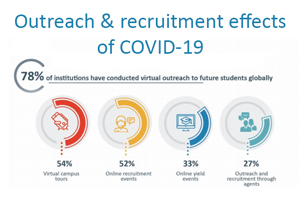
As institutions adapted to serve their current students in light of the COVID-19 crisis, international student recruitment and outreach also changed. International recruiters often travel much of the spring to meet with accepted students and their families, visit schools with high acceptance rates and meet with counselors in regions that they wish to grow their populations. Spring yield travel, as it is known, supports student decision-making in the crucial months before deposit deadlines. The restrictions that have resulted from the global pandemic were a huge disruption to typical recruitment practices and wisdom. An IIE survey released last week reported that of the 599 respondents, more than 63% of institutions indicated their recruitment travel was canceled, and 57% of institutions canceled recruitment events. Many colleges and universities (78%) quickly pivoted to virtual means to reach international students. Virtual tours, online recruitment and yield events and increased digital outreach via email and agent networks became the primary means of maintaining contact and converting acceptances to enrollments.
To support institutions, the EducationUSA network of over 400 educational advising centers in 180 countries also pivoted. The network shifted their activities to on-line through virtual one-on-one and group advising sessions, webinars, virtual college fairs, and an enhanced on-line and social media presence.
In addition to changing their spring yield travel and events, 84% of institutions enacted new measures to assist in international student recruitment. New measures reported in the IIE survey mostly aligned with AACRAO Guidance on admissions practices, like flexibility in testing, accepting unofficial documents, and extending deadlines.
The majority (88%) of respondent institutions in the IIE survey anticipate that international student enrollment will decrease for the 2020-2021 academic year. This is not a surprise.
Just as institutions are questioning their overall fall enrollments, international student enrollments are at even greater risk. Will the institutional adaptations be enough to mitigate the social, economic and political factors that are obstructing international enrollments? As of today, travel remains restricted globally, US Embassies and Consulates are not open for issuing visas, and the global economy is uncertain.
And yet, commitment to international education remains strong.
Rather than lose their recruited students entirely, 52% of reported institutions indicate that they plan to offer students online enrollment in the fall, and 42% indicate that they will offer online instruction until the student can come to campus in-person. This is a new model of international enrollment for US institutions, who generally do little to recruit an international student cohort for their online programs. Enrollment numbers for non-US citizens in online programs are not currently captured in any longitudinal or comprehensive data collection efforts. The impacts of COVID-19 have already piqued the interest of the Department of State, and may eventually find their way into future Open Doors reports. It's clear that the paradigm is shifting. What’s less clear is the long-lasting impact of the pandemic on institutional international enrollment strategies and goals.